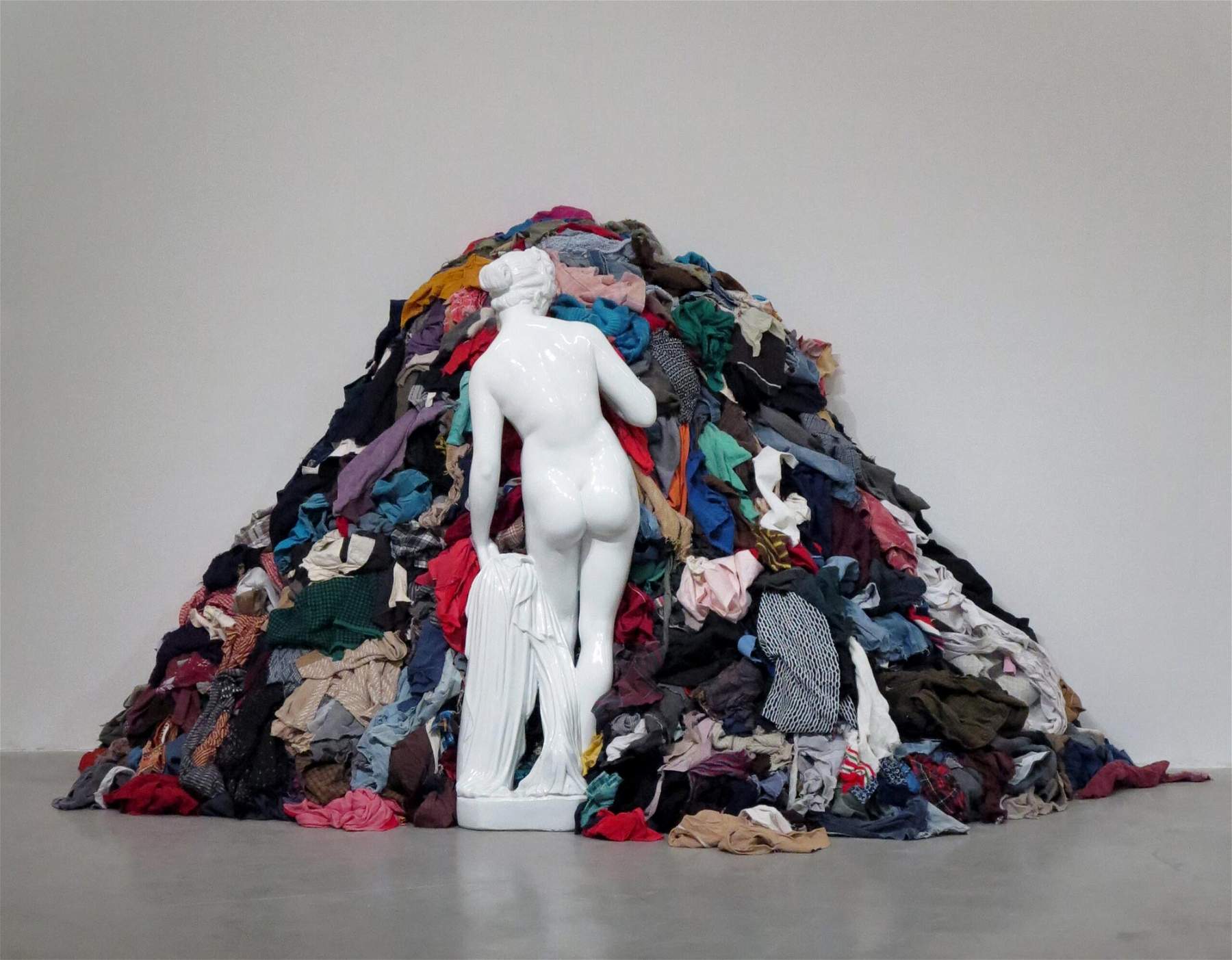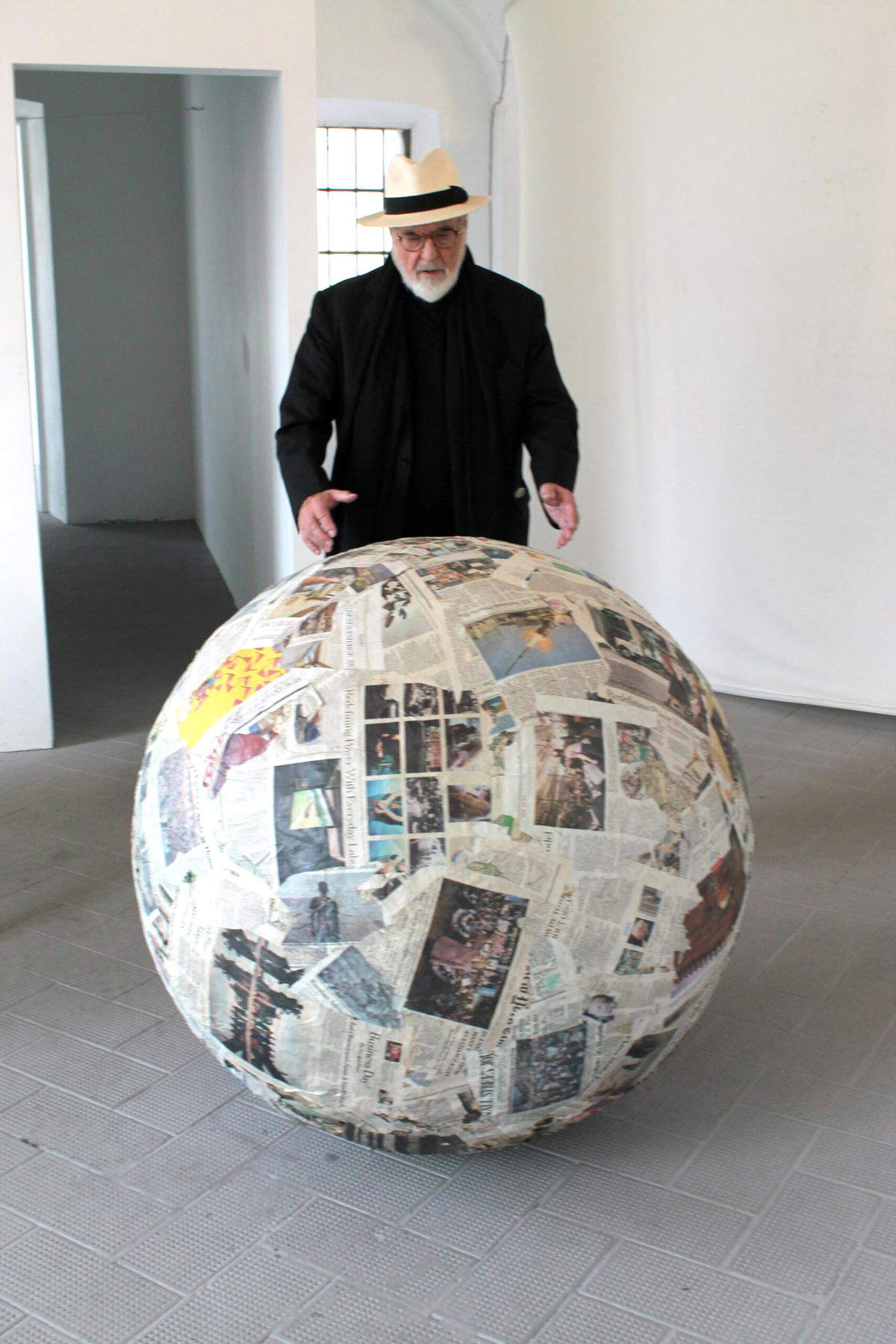The Municipal Museum of Modern Art in Ascona is hosting, from May 30 to September 26, 2021, a major exhibition on Michelangelo Pistoletto (Biella, 1933), entitled The Truth of Michelangelo Pistoletto. From the Mirror to the Third Paradise: organized in collaboration with Cittadellarte - Fondazione Pistoletto of Biella, it is the most important and comprehensive solo exhibition of the artist ever held in Switzerland. Curated by Mara Folini and Alberto Fiz, the exhibition showcases forty works including paintings, mirror paintings, installations, videos and rare archival images, from 1958 to 2021, some iconic such as The Venus of Rags, Metro Cube of Infinity or the Mirror Paintings, others exhibited only in rare circumstances, such as the politically themed works of the 1960s, which refer to the interdisciplinary experience of Zoo. The exhibition is completed at the Castello San Materno Museum, where visitors will be welcomed by Pistoletto himself who, through an interactive video projection, introduces the themes of The Third Paradise, one of his most emblematic environmental works.
The Third Paradise, created in the castle’s park using some 90 plants, is a theme Pistoletto has often addressed in recent years: it is the mathematical symbol of infinity that accommodates within it a central third circle, in a triadic dynamic that, on a conceptual level, refers to three moments in human history (the first is that of the origins, in which man was totally integrated into Nature, the second is the Artificial one, developed by human intelligence, up to the global dimensions reached today with science and technology, and the third is the one that stands at the center of the other two, as overcoming the current conflict between nature and artifice, and implying a new model of an eco-sustainable, deeply democratic and inclusive society). The Third Paradise at the Castello San Materno Museum, will be enlivened throughout the summer, that is, from June to September, by themed proposals made by various cultural organizations in the Locarno region.
It was decided to organize an exhibition by Pistoletto in Ascona by virtue of the presence at Monte Verità, a meeting point at the beginning of the last century for nonconformist artists and intellectuals from all over Europe, of a Third Paradise made with the use of large stones smoothed by time that will be donated by the artist and reveals the continuity between his thought and this emblematic place in Ascona.
 |
| Michelangelo Pistoletto, Venus of rags (1967 Cement, enamel and rags, 140 x 240 x 80 cm). Courtesy Galleria Continua, San Gimignano |
The exhibition itinerary set up on the two floors of the Museo Comunale d’Arte Moderna di Ascona begins with the section documenting the birth and evolution of Quadri specchianti with seven emblematic works including La folla (1958-1959) and Autoritratto oro (1960) that anticipate the revolution that shortly followed. If La Folla presents an anonymous multitude emerging from the background of the painting, Autoritratto oro has the gold background as its reference and expresses the need to release the emptiness behind the figure. In 1962 Mirror Paintings burst onto the scene, and on display is 1963’s Bottle, one of the earliest examples made with this technique, where an everyday element appears, without emphasis, at the bottom of the mirror. Another particularly significant work is Father and Mother from 1968, with Pistoletto’s parents seen from behind, in the same position as the viewer facing the mirror. Theexcursus, which also includes two mirrors from the 1970s, Nude Woman with Gloves and Blue Cage, is completed by Self-Portrait with Notebook Third Paradise from 2017, which seems to be in dialogue with Self-Portrait Gold from almost fifty years earlier.
The exhibition continues with a series of iconic installations from the 1960s including the Labyrinth, made of corrugated cardboard, from 1969 that completely invades the room, inside which appears the 1965 Well that is part of the Minus Objects also made of corrugated cardboard and mounted in a circular form, while on either side of it are two paradigmatic works in the renewed linguistic context expressed byArte Povera, such as the celebrated Venus of Rags from 1967 and the Brick Wall from 1968. The installations relate to Divided Mirror, 1973-1978. The second half of the 1960s is also characterized by the collective actions and theatrical performances, which are evoked extensively and in depth through videos and photographic material. These include images describing the experience of “Zo ”o, the company created by Pistoletto in 1968 that proposed theatrical and performance actions in contexts outside officialdom.
In the center of the long corridor, viewers can enjoy freely moving Sphere of Newspapers, which repurposes a historical work belonging to the series of Minus Objects that already in 1967 was used for an action performed on the occasion of the collective exhibition Con-temp-action. The recycling of information, fluid communication, the overlapping of news and its zeroing, are just some aspects that make Sfera di giornali (Sphere of Newspapers ) particularly topical, which, during the exhibition, will move from the museum to the streets of Ascona in a performance intended to involve the inhabitants of the Borgo. An entire section is dedicated to Segno Arte, another fundamental research of Pistoletto’s, namely a figure, consisting of the intersection of two triangles that ideally inscribes a human body with arms raised and legs spread apart. Of this form, which corresponds to the maximum extension of the body, a number of works in different materials are proposed, such as Door-Sign Art, Window-Sign Art, Thermosiphon-Man-Sign Art, Dumpster-Sign Art, Through Sign Art.
On the second floor of the Museum are a number of recent installations of particular significance including Time of Judgment (2009), which ideally represents a temple in which the four great religions (Christianity, Buddhism, Islam, Judaism) are induced to reflect on themselves by placing themselves in front of the mirror with Infinity Metrocube (1966) in the center, a work consisting of surfaces that are externally opaque but mirroring inward, making the possibilities of refraction reach their climax. The exhibition closes ideally with Love Difference-Mar Mediterraneo, a large mirrored table in the shape of the Mediterranean basin, surrounded by chairs from the different countries bordering this sea. Love Difference, which was presented in 2003 at the Venice Biennale when Pistoletto won the Golden Lion for Lifetime Achievement, is a programmatic announcement, a movement that combines the universality of art with the idea of political transnationality. Also in 2003, the artist wrote the manifesto of the Third Paradise and designed its symbol, consisting of a reconfiguration of the mathematical sign of infinity. Large photographs of the Third Paradise installations on the Louvre Pyramid (2013), in the waters in front of Havana (2014), in the Park of the Palace of Nations in Geneva (2015) or on the logo of the International Space Station mission in 2017, act as a trait-d’union with the new Third Paradise installations that can be seen at Monte Verità and the Castello San Materno Museum. Accompanying the exhibition is a bilingual (Italian-English) Edizioni Casagrande catalog, with texts by Mara Folini, Alberto Fiz, and Paolo Naldini, an intervention by Michelangelo Pistoletto, and an interview with Pistoletto by Hans Ulrich Obrist.
 |
| Michelangelo Pistoletto, Gold Self-Portrait (1960; oil, acrylic and gold on canvas, 200 x 150 cm). Photo D. Andreotti |
 |
| Michelangelo Pistoletto, The Third Paradise (2014). Dec. 16, 2014 Dozens of fishing boats form the symbol of the Third Paradise in the waters in front of Havana, Cuba. Event curated by Galleria Continua. Photo: Paola Martinez Fiterre & Alejandro Mesa Crespo |
 |
| Michelangelo Pistoletto pictured with his work Sphere of Newspapers (1966 - 2017; pressed newspapers, 100 x 100 cm). Photo A. Lacirasella |
“Looking at the extraordinary work of Michelangelo Pistoletto,” says Mara Folini, director of the Municipal Art Museums of Ascon, "in the cultural context of the Locarno region, a land of anarchists and theosophists even before the community experience of Monte Verità, it is precisely the concept of change, of ’demopraxia,’ which Pistoletto with Cittadellarte is pursuing extensively around the world, promoting the concept of the Third Paradise in fact, to be an innovative practice that makes a difference, compared to the equally uplifting intentions of as many committed artists. Setting up articulated processes of relational, peaceful and constructive activism from below is, in other words, quite different from the romantic, visionary and utopian dream of the historic artist communities of past centuries, such as that of Monte Verità, which ended up being closed experiences, the “archadias” of a select few, disconnected from societies. Thus, I hope that out of this ambitious project linking local history to the present day, something productive and stimulating can come out for Ascona and its region as well."
“The issues raised by Michelangelo Pistoletto,” emphasizes Michela Ris, Head of the Culture Department of Ascona’s City Hall, “related to the preservation of our planet, sustainable development and the democratic inclusion of differences, are so topical and urgent that I hope they can become topics of discussion in Ascona’s City Hall, as an opportunity for reflection and stimulus to increase innovative projects, ever closer to the well-being of citizens. Encouraging a policy that looks at green and sustainability as added values of a town like Ascona, renowned for having been the land of visionary ante litteram ecologist artists, means enhancing the legacy of those who have preceded us, doing justice to it in facts.”
“The one in Ascona,” says Alberto Fiz, “is a comprehensive review that allows for an in-depth analysis of the entire creative iter of Pistoletto, among the major protagonists of international artistic research from the 1960s to the present. Pistoletto has radically transformed the relationship with the work of art, which, thanks to his investigation, stands as a relational principle where meaning does not lie in the thing itself, but in the passage between things. And all this on the basis of a multiple, dynamic and expansive perspective that absorbs the temporal dimension as a happening that changes at the very moment it is produced.”
The exhibition opens Tuesday through Friday from 10 a.m. to noon and 2 to 5 p.m., Saturdays from 10 a.m. to 5 p.m., Sundays and holidays from 10 a.m. to 4 p.m. Closed Mondays. Tickets: Municipal Museum of Modern Art 15 francs full, 10 reduced; San Materno Castle Museum 10 francs full, 7 reduced. The ticket entitles the holder to visit the museum. You can also buy a combined ticket: 17 Swiss francs full, 12 reduced. Free admission for children under 18. For info: phone +41 (0)91 759 81 40, email museo@ascona.ch, website www.museoascona.ch.
 |
| Michelangelo Pistoletto's Truth: major exhibition of the artist of the Third Paradise in Switzerland. |
Warning: the translation into English of the original Italian article was created using automatic tools. We undertake to review all articles, but we do not guarantee the total absence of inaccuracies in the translation due to the program. You can find the original by clicking on the ITA button. If you find any mistake,please contact us.